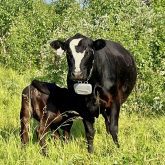When it came to determining the best data management software program for her herd, like many beef producers, Amy Higgins found the possibilities a tad overwhelming.
“It was almost like analysis paralysis,” says Higgins, who runs the Maritime Beef Council and raises cattle at Quispamsis, New Brunswick. “There were four or five different options. I knew that … getting started and investing the time to get the data put into any one of them was going to be time-consuming.”
The 2017 Maritime Beef Strategy identified better data management as a priority, with data flow necessary for premium programs that focus on sustainability, such as Verified Beef Production Plus and Prince Edward Island Certified Beef. However, many producers throughout the Atlantic Provinces were in the same boat as Higgins, bringing questions to the council about how to choose the right software for their operations.
Read Also

Building demand together: The impact of Canada’s beef import levy
The beef import levy has become a central tool for ensuring balance in Canada’s beef industry
To assist with providing recommendations, the Maritime Beef Council launched a two-year pilot project to collect producer analysis on several data management programs. About 30 producers participated in total, and each producer was assigned one of five software programs to test: BioTrack 360, Cattlemax, Herd Trax, Herdly and LivestockED.
Participants prioritized different metrics and features, depending on what was most valuable to their operations. “Not surprisingly, it varied between producers, and that largely depended on the amount of data that the producers themselves were capturing,” says Higgins. This had an impact on how they viewed the usefulness of each program.
Each program tested offers herd inventory reporting and records for breeding, calving and health treatments, as well as options for creating custom reports. More robust data analysis options are available with HerdTrax and BioTrack 360, and both programs allow people to share data along the value chain.
Overall, Cattlemax and Herdly were recommended for the average Maritime cow-calf producer (with a cow herd of 30-50 head), having received the highest scores in the pilot. Cattlemax offers all basic record-keeping metrics, with the entire program available for mobile as well as desktop, and it can import information from breed association registries. For those with mobile data or limited Wi-Fi access, printable record-keeping sheets are available to use chute-side before inputting the data once internet is available.
Participants found Herdly easy to use, with ample troubleshooting tools available, and the value of the program fit the price for small or mid-sized cow-calf programs. This was one of two software programs tested that synchronizes with the Canadian Livestock Tracking System for tracing animal movement, the other being HerdTrax. One drawback is that Herdly’s mobile application, while rated as excellent, is not available on Android devices.
For producers with larger herds or feeder components to their operations, HerdTrax was given good reviews, with participants finding value in the program’s ability to use progeny performance data to create maternal and terminal indices. However, those with smaller cow-calf herds found it offers more than what they require, with the price a little high for the number of features they actually used.
BioTrack 360 was the most expensive program tested, and while it has a strong genetic evaluation feature, participants found it hard to troubleshoot. None of the participants planned to continue using it after the pilot, noting that the value it offered didn’t correlate with its price and that other programs would better suit the average cow-calf producer in the region.
LivestockED was tested in the first year, and while producers said it was easy to use, they found it to be quite basic and wanted to try other programs to get better value for their investment. As such, this program wasn’t recommended by producers.
One of the pilot’s overall findings was that any method of data management required time and effort, and regardless of the program, “there is some time investment into getting it set up and to getting it set correctly to save you heartache down the road,” says Higgins.
The degree of ease in inputting data into the program was a major factor in whether or not the producer decided to continue with a specific program. Some producers indicated that they continued capturing data manually, especially for heat detecting and breeding, even if they later compiled it into a software program.
Producer feedback also highlighted the importance of starting small by adding a few animals and current data into the system, then inputting past information later. “It’s as complicated as you want to make it,” she says.
Several programs have a free trial period, and you can use that to begin simply and see if you like the program before spending the time required to transfer the entire herd and years of data into it. “Put a couple animals in — you don’t have to put them all in — see how easy it is to just do simple things like add a calf, do a vaccination run and those things that you would theoretically be doing in high volume,” she advises.
Among the challenges identified with these programs during the pilot were compatibility issues with scale heads and reader wands meant to automate the flow of data into the software.
“In theory, you should be able to plug that in and bounce it over into a data management software relatively easily, but there are definitely differences in ease of compatibility with some of those types of things,” says Higgins.
Difficulties arose for participants who register purebred cattle with national breed associations, as none of the tested programs had an interface that easily transferred data to a breed registry.
“Sometimes it felt like it was duplicating a lot of those efforts because you had to go through your breed registry process to register all over again after you had done all of the work to get it into your data management software,” she says.
As well, some producers ran into trouble in areas with limited internet and mobile data network access, prompting those participants to return to manual record-keeping methods.
At the project’s conclusion, 40 per cent of participants indicated they would continue to use the software program they tested, while 30 per cent said they wanted to try a different program that was part of the pilot. The other 30 per cent planned to return to their previous record-keeping methods, whether that be on paper or with a spreadsheet program.
The Maritime Beef Council will be sharing the results of the pilot through a two-page document, available in English and French on its website (maritimebeef.ca) and in hard copy at in-person events.

















